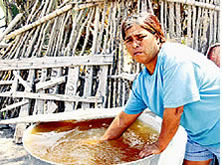Desert Communities Face Water Shortage
 Roberto Aguilar Grimaldo - El Universal Roberto Aguilar Grimaldo - El Universal


| | Residents resort to using non-potable water due to the seasonal shortages in parts of Tamaulipas state (Photo: Roberto Aguilar/El Universal) |
Tula, Tamaulipas - Felipa Gómez Rosales draws a bucket of green-tinted water out of a small pond in front of her home. Just a few moments earlier, a group of goats was refreshing itself at the pool, and as Felipa fills another bucket, frogs scurry out of the way to hide in the muck at the bottom.

"It's mostly for housekeeping, clothes-washing and such," she replies when asked what the water is for. "But if necessary, it's for drinking, too. It's been a month now since the tanker trunk has come to give us potable water."

And like many of the other residents of El Gavial, a community of 160 belonging to the municipality of Tula, she treats the water drawn from the pond almost exclusively with the sap extracted from nopales, or cactus paddles.

One-hundred-forty kilometers southeast of Tamaulipas' state capital, Ciudad Victoria, sits Tula, a municipality of 32,000 inhabitants scattered amongst 102 different communities. This is an arid, semidesert area that suffers especially at this time of year at the end of the long, hot, dry season.

And according to Tula's municipal president, Cruz Walle Meza, when the communities start to run out of potable water, they begin turning to the pond and ditch water meant only for animals.

El Gavial has a pumphouse and pipeline connecting it to a reliable water source in Magdaleno Cedillo, 10 kilometers away. But there's no electricity to run the pump these days, so, as local farmer Óscar Gómez Walle explains, "Sometimes, we have to go over there in trucks to get the water."

However, state director of water resources, Rodrigo Morales Loo, insists that Tamaulipas is one of the highest-ranked states when it comes to potable water coverage. Still, he says that the state is looking for solutions in areas that continue to have water shortages. "We need to make the wells more efficient, start utilizing power cells to make pumping operations more energy efficient, get windmills going, and perfect methods of rainwater collection," he says.

The governor of Tamaulipas, Eugenio Hernández Flores, adds that 24 million pesos have been earmarked for improving water service in communities in the state's desert and semi-desert areas.

State Secretary for Social Development Homar Zamorano has announced a 24-million-peso expenditure to improve water reserves in 55 rural communities.

But according to one of Tula's Catholic priests, Enrique Gómez Ramírez, locals are looking for help from non-governmental sources as well.

"The people suffer greatly for the lack of water here; children, especially, get stomach sicknesses," he says. "Now the believers are forming processions in the various ejidos (communal farming units) and they pray for rain." |



